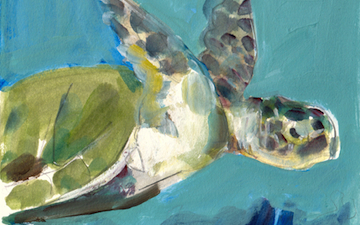Chelonia mydas, known as the Green sea turtle, is a large sea turtle belonging to the family Cheloniidae. It is the only species in the genus Chelonia.[1] The range of the sea turtle extends throughout tropical and subtropical seas around the world, with two distinct populations in the Atlantic and Pacific Oceans.[2] Their common name derives from the often green fat found beneath their carapace.
The Green Sea Turtle is a sea turtle, possessing a dorsoventrally flattened body covered by a large, teardrop-shaped carapace and a pair of large, paddle-like flippers. It is usually lightly colored, except that its carapace‘s hues range to almost black in the Eastern Pacific. Unlike other members of its family such as the Hawksbill Sea Turtle and Loggerhead Sea Turtles, Chelonia mydas is mostly herbivorous. The adults commonly inhabit shallow lagoons, feeding mostly on various species ofseagrass.[3]
Like other sea turtles, they migrate long distances between feeding grounds and hatching beaches. Many islands worldwide are known as Turtle Islands for the Green Sea Turtle that nest on their beaches. Females haul out onto beaches, dig nests and lay eggs during the night. Later, hatchlings emerge and walk into the water. Those that reach maturity may live to age 80 in the wild.[2]
Chelonia mydas is listed as endangered by the IUCN and CITES and is protected from exploitation in most countries. It is illegal to collect, harm or kill them. In addition, many countries have laws and ordinances to protect nesting areas. However, turtles are still in danger because of several human practices. In some countries, turtles and their eggs are hunted for food. Pollution indirectly harms turtles at both population and individual scales. Many turtles die caught in fishing nets. Finally, real estate development often causes habitat loss by eliminating nesting beaches.
(From Wikipedia.org, Oct. 12 2010)
– – –
Green turtles are long-lived and may take up to 59 years to reach sexual maturity (6) Undertaking tremendous feats of navigation, adults return to the same beach to breed each season, part of the population in Brazil astonishingly migrates around 2,250 kilometres across the open ocean to breed on the Ascension Islands (12). Mating tends to occur just offshore of the nesting beaches; using a curved claw on each front flipper and a flat nail at the end of the tail, males are able to grip their mates (2). Females haul out onto the beach at night and dig large nests with their back flippers beyond the high tide mark, they typically lay between 100 and 150 eggs in one nest and then proceed to cover the eggs with sand; the whole process takes around two hours (6). A single female returns to breed only once every two to five years but will lay up to nine nests in that one season (2). Incubation takes between 45 and 70 days, and temperature has been shown to determine of the sex of hatchlings; with females being produced at warmer temperatures (6). Breaking open their eggs with a special hooked ‘egg tooth’ that will subsequently be lost; hatchlings use their powerful front flippers to reach the surface, and then proceed to the sea (7). The soft-bodied juveniles are particularly vulnerable at this time from a variety of predators, such as ghost crabs and gulls on the beach to sharks and dolphins in the water (7). Unlike other marine turtles, adult green turtles are almost exclusively herbivorous, grazing on seagrasses and algae (8); it is assumed that juveniles are more omnivorous although the exact composition of their diet is unknown (6)
(From ARKive via The Encyclopedia of Life, Oct. 12 2010)
—




